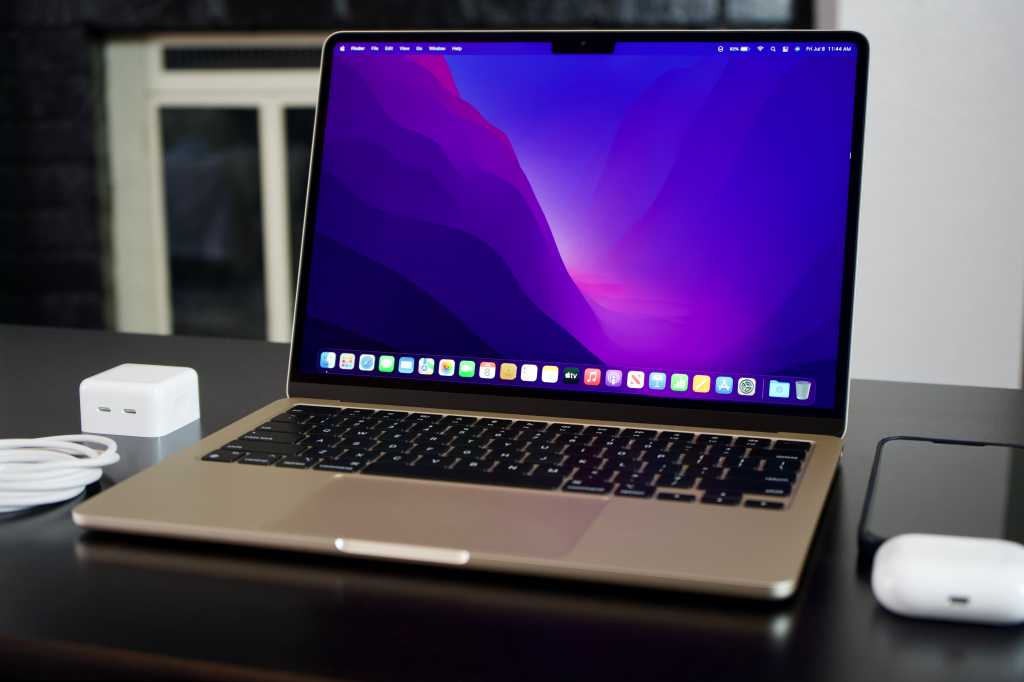Expert’s Rating
Pros
- Improved display with thinner bezels
- Full-size function row
- Killer battery life
- Outstanding performance in its class
Cons
- Webcam still disappoints
- The price has gone up
- 256GB model has reduced storage performance
Our Verdict
Apple’s first major redesign of the MacBook Air in a dog’s age is largely a success. The webcam still disappoints, but in every other way this will be a delightful everyday computer for most users.
Price When Reviewed
$1,199
Best Prices Today: MacBook Air M2 (2022)

$1199

Not Available
Free
So you’re ready to buy a new laptop. What do you need it for? What do you really need it for?
It’s tempting to look at something top-of-the-line, but most of us aren’t doing complex professional video edits on 4K video, heavy-duty scientific work, or really big coding projects every day. Most of us spend our time with some browser tabs open, a handful of apps for email and messaging, editing photos or maybe some simple videos, watching streaming video, that sort of thing.
If you’re a gamer that wants to play the latest games, our sister site PCWorld can point you in the direction of a Windows laptop, but for everyone else–everyone who doesn’t use their laptop for very intensive tasks all day long, the MacBook Air is exactly what you need.
Newly redesigned for the first time in years, the M2 MacBook Air has more than enough muscle to make quick work of everyday tasks, but it’s wonderfully thin and light with a big beautiful display and killer battery life. It’s not quite as affordable as it used to be, but it’s a lot less expensive than a 14-inch MacBook Pro and still the best Mac laptop choice for most people.
Design improvements, but no surprises
The MacBook Air has essentially had the same profile since around 2010, when Apple introduced the tapered aluminum unibody design. Eight years later it got a few tweaks (the display got a Retina upgrade and thinner black bezels, and the ports switched over to USB-C), but the MacBook Air has essentially looked the same for over a decade.
The new M2 MacBook Air finally gives us a different, if not new, design. The new body is flat, with flat sides and a slightly thicker lid. It’s just as wide as the old MacBook Air (just under 12 inches) and only one-tenth of an inch deeper. It’s quite thin–thinner than the thickest part of the old Air, but much thicker than the thin tapered edge of its predecessor.
As a result, even though this new design technically has less volume than the old one, it doesn’t feel smaller. It feels just slightly larger and about the same weight. The smooth curve around the bottom edge feels better in the hand than the sharp edge of the old design.
It’s a little disappointing to see the essential “Air-ness” taken out of the design; it’s just like the MacBook Pro squashed thinner. But it’s hard to argue that it doesn’t look and feel good, and is still unmistakably a MacBook.
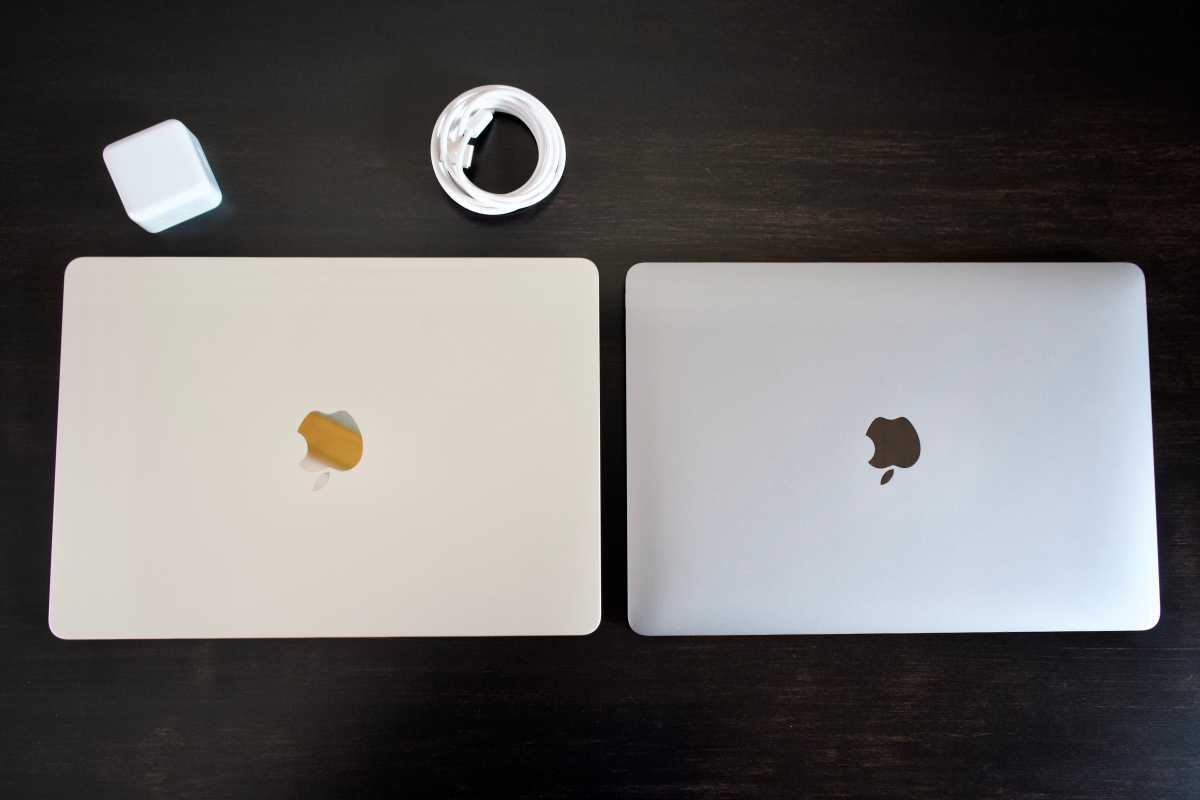
IDG
The display is larger–13.6 inches rather than 13.3–thanks mostly to smaller bezels around it. It’s a much more modern look than the old Air, though there are competing laptops with thinner bezels. The keyboard and trackpad are more or less the same (if it ain’t broke…), but the half-height Function row has been expanded to full-height keys. And the speaker grilles on the side of the keyboard are gone too, resulting in a much cleaner aesthetic.
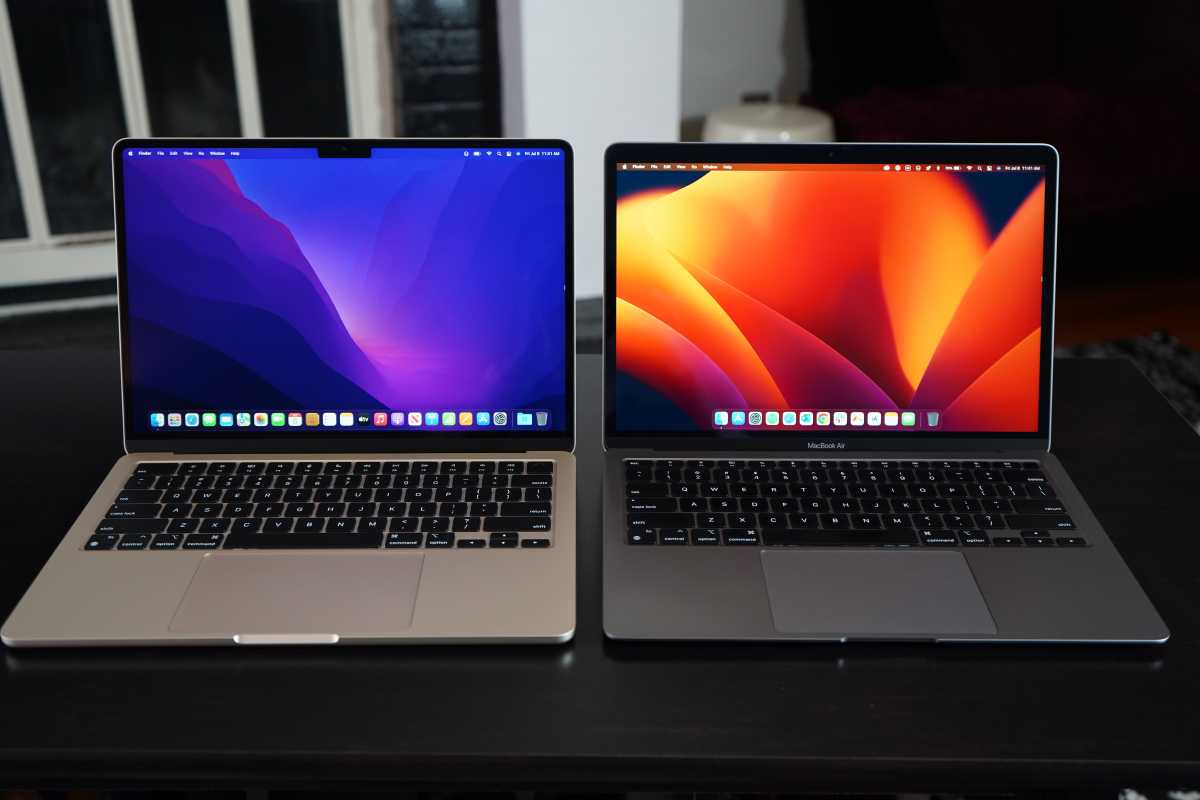
IDG
Apple has changed up the colors a little, too. Silver and Space Gray (still a fairly light shade of gray) are sticking around, but the old gold color is gone. In its place are two new colors: Starlight and Midnight, as seen on the iPhone SE and Apple Watch Series 7. Starlight a basically a bright silver with a hint of gold to it, and Midnight is a very dark grey with just a bit of blue. They’re both quite nice, but Midnight is going to be a runaway hit. (Note to Apple: People want a black laptop.)
You’ll still find two USB 4 / Thunderbolt ports on the left, which is a little sparse though the addition of a MagSafe charging port definitely helps. It’s a welcome return after years of USB-C-only charging. The headphone jack on the right now supports high-impedance headphones as well.
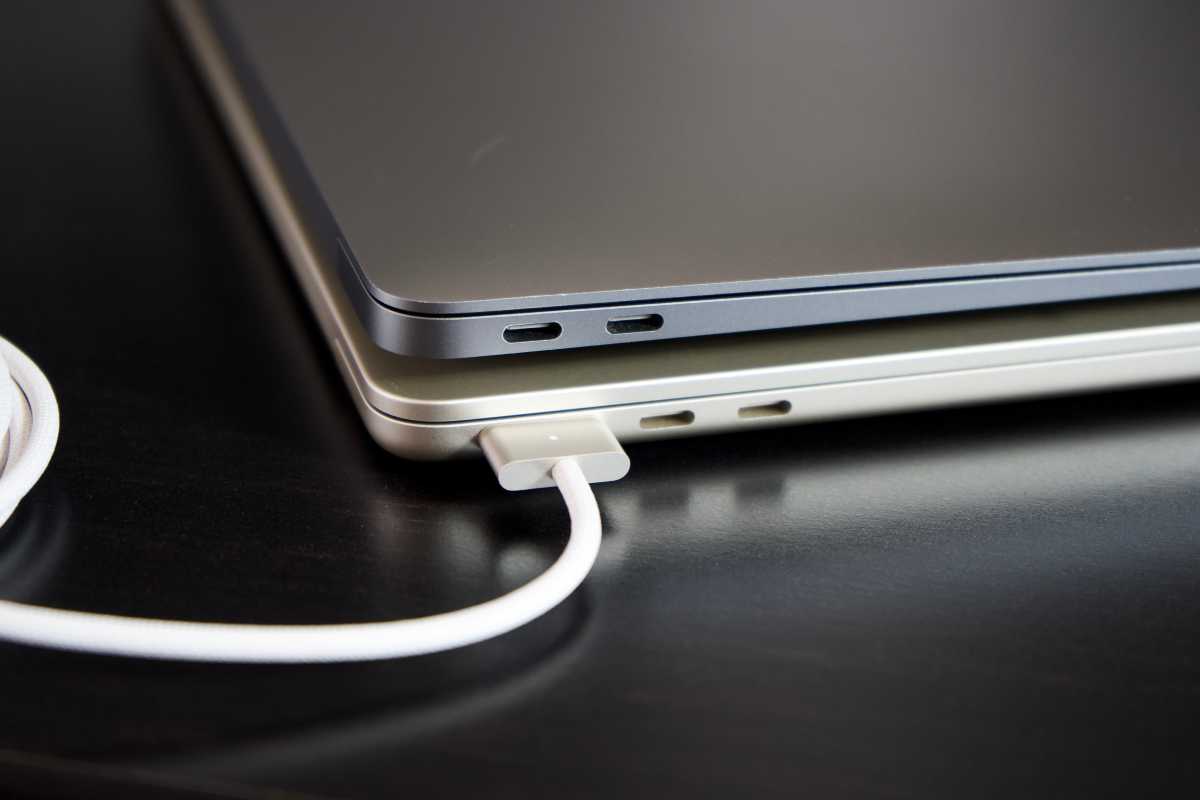
IDG
You’ll notice the display has a notch in which the 1080p webcam resides, just as it does on the 14-inch and 16-inch MacBook Pro. It’s honestly not very distracting and actually adds screen real estate rather than taking it away since the area below the notch is the standard 16:10 Mac display ratio, the notch and menu bar extend up above it, adding 64 rows of pixels. The display is otherwise the same as that on the old MacBook Air, only it gets 25 percent brighter (up to 500 nits). It’s a nice display, but nowhere in the league of the XDR ProMotion displays on the high-end Pro laptops.

IDG
Still a disappointing webcam
I wish I had good things to say about the new 1080p webcam, but I don’t. Sure, 1080p sounds like a step up from the old 720p webcam, but in practice, it’s still extremely grainy and performs terribly in low light.
Even in relatively good office light, images will be full of noise and grain. Apple’s processing has improved over the years, but it’s still not a very good overall experience. Resolution isn’t everything; it’s likely that Apple simply needs a much better sensor and lens system.

IDG
Fortunately, a new feature coming to iOS 16 and macOS Ventura this fall called Continuity Camera will let you use your iPhone as a webcam in nearly any Mac app that uses the standard webcam frameworks. It makes a shocking difference, as you can see above.
The new Air has a four-speaker array that sounds pretty great for a laptop this size, better even than two speakers in the M1 MacBook Air. The three-mic array doesn’t seem any different–it’s still great for video calls and the like but you wouldn’t want to use it for music recording.
Some entry-level caveats
We already got a look at what to expect from the new M2 processor in our review of the upgraded 13-inch MacBook Pro. The M2 in the MacBook Air is no different, so you can expect approximately the same performance here.
Our configuration of the MacBook Air has the following specs, and is priced at $1,899:
- M2 SoC with 8 CPU cores
- 10-core GPU
- 16GB of unified memory
- 1TB SSD
There are three things to note before we get to the numbers. First, the MacBook Air’s new design is still totally fanless. That means blissful silence, but it also means that under sustained heavy workloads it will not be able to hold to the same performance as the MacBook Pro, which has a fan to keep the processor cooler. The difference is small (a few percent), and only noticed in particular circumstances that hammer on the processor for an extended time, but it’s there.
Second, the entry-level MacBook Air has only 8 of the M2’s 10 GPU cores enabled. You can expect that configuration to exhibit around 20 percent lower graphics performance than what you see here.
And finally, if you get the entry-level model with 256GB of storage, Apple has confirmed that you’re getting the same single 256GB chip as in the M2 MacBook Pro, which will reduce speeds by as much as 50 percent compared to models with more storage. We suggest avoiding the 256GB models, not only for that reason but also because you’ll probably be running out of storage sooner than your think.
Expected performance gains
Let’s start off with Geekbench 5 CPU performance numbers, which are a common measure of peak CPU performance for both a single core and all cores. As you can see the M2 MacBook Air delivers peak performance right in line with the M2 MacBook Pro, and a bit better than the M1. It’s a nice improvement, but it’s not on par with the higher-end M1 Pro and Max processors.
Cinebench R23 uses the CPU to perform ray-traced rendering on a static scene, and the test runs through several loops to measure sustained performance. Here, you can see the active cooling of the MacBook Pro makes a difference. While the new MacBook Air is 15 percent faster than the M1 model, it’s still 10 percent slower than the M2 MacBook Pro.
While the MacBook Air is not really meant for those who work in Final Cut Pro or Adobe Premiere all day, it’s certainly reasonable to expect everyday users to do a little light video editing in iMovie. In our tests, we take an extended 4K video clip and perform video stabilization on it, then export it at full resolution in both ProRes and H.264.
Here, we start to see a marked difference between the M1 and M2. The M2’s video hardware supports encoding and decoding ProRes, which makes a huge difference when exporting in that format. Performance is once again similar to the M2 MacBook Pro, sometimes just a tiny bit slower (perhaps thanks to the MacBook Pro’s fan).
Let’s take a look at a different video test, this time using the popular Handbrake tool. We use Handbrake 1.5 to transcode Blender’s free Tears of Steel video from 4K to a 1080p H.265 file. When using just the CPU cores, it finished almost 33 percent faster than the M1 MacBook Air. When using the hardware encoder, that time gets cut down a lot, and the M2 MacBook Air is about 21 percent faster than its predecessor.
Apple does not play around when it comes to SSD performance. Our Blackmagic Disk Speed Test show just under 3 GB/sec of read performance (about the same as the M1) and just over 3GB/sec of write performance (about a 30 percent improvement). It’s not a groundbreaking change, but it’s quite good for a thin and light notebook. (Note, though, that performance for the 256GB model will be reduced by up to half.)
The Geekbench 5 Compute scores use the GPU to perform special-purpose computation tasks like facial recognition, depth-of-field, or horizon detection. It can use either the OpenCL or Apple’s Metal API. It’s a quick test, so it’s not surprising that scores are right in line with the M2 MacBook Pro. It’s almost 60 percent faster than the old M1 MacBook Air (hardly a surprise given that is was the entry-level model with 7 GPU cores), and about 40 percent faster than the “full” M1 with 8 GPU cores in the M1 MacBook Pro.
A MacBook Air has never been a great gaming laptop, and even the improvements we find in the M2 don’t change that. But it’s interesting to see how much better it is at running premium games than the M1.
The M2 MacBook Air, with a full 10-core GPU, is roughly 40% faster than the M1 Air with 7 GPU cores in Rise of the Tomb Raider, and between 20-50 percent faster in Civilization VI, depending on the settings. That’s the good news. The bad news is neither of these games delivered a solid 60 frames per second without seriously compromised visual settings. Don’t expect gaming miracles out of a fanless ultraportable laptop and you won’t be disappointed, I guess.
Awesome battery life and faster charging
Apple claims up to 18 hours of movie playback with the M2 MacBook Air, about the same as the M1 model and a couple of hours less than the M2 MacBook Pro, which has a larger battery.
That wasn’t quite our experience, but it’s close. With the display set at 150 nits and playing back a movie on an endless loop in the TV app, our battery lasted 17.5 hours—very close enough to Apple’s 18-hour claim. It also outstrips the M1 MacBook Air and M2 MacBook Pro by almost an hour and a half.
In regular daily use, battery life is just as great. It’s a weird feeling, opening up your laptop and doing work for 20 minutes and seeing that the battery percentage hasn’t changed even a single percent, but that’s how it is with Apple silicon. Obviously battery life varies based on what you’re doing, but for this laptop’s target market–the everyday home and productivity user–it’s hard to think that you’ll ever have to charge up before the day is done.
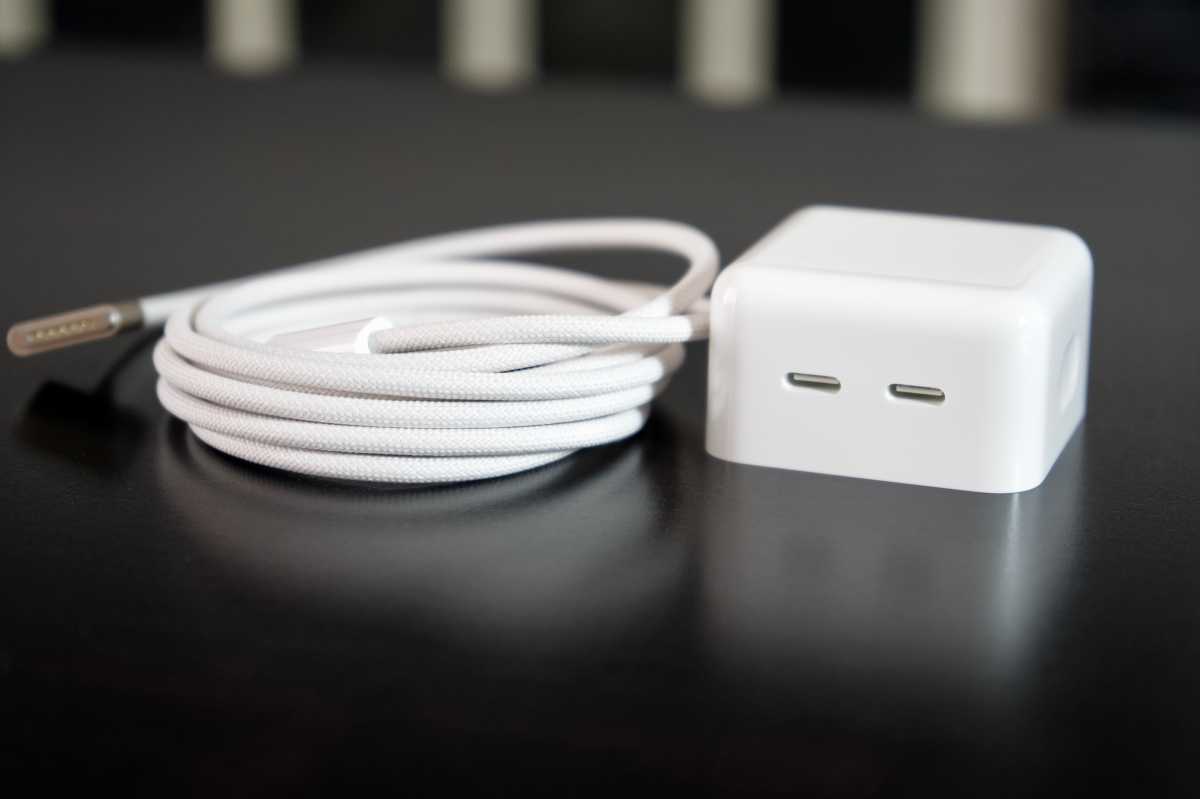
IDG
When you finally do plug in, you’ll be glad to see that Apple has amped up charging speed if you have a good USB-C power adapter. With the 35W dual-port adapter that comes with all models of the Air aside from the entry-level model (another reason not to buy it), I got back about a 10 percent charge every 10 minutes. When I swapped out for Apple’s 61W USB-C Power Adapter, I went from 25 percent to 72 percent in 30 minutes, essentially confirming Apple’s “50 percent in 30 minutes” claim.
Should you buy an M2 MacBook Pro?
For most of us, the new M2 MacBook Air is all the laptop we’ll ever need. Unless you do some seriously high-end video editing or other computationally-intensive work all the time, you have no need for MacBook Pro. Sure the extra ports of a Pro might seem handy, and the HDR ProMotion display is really nice, but you’re paying a lot more for power you’ll never need, not to mention lugging around a bigger, thicker, heavier laptop.
Apple’s new MacBook Air isn’t a revelation, but it’s a nice upgrade over the previous model. The larger, brighter display with thinner bezels is a nice improvement, MagSafe charging is back, and it’s got frankly incredible performance for a 2.7-pound computer that can do well over a full day of real work on a single charge.
It’s got a great keyboard and trackpad, really good speakers and mics for a laptop this size, and you don’t have to worry about fan noise because there is no fan. I wish the webcam was better–it’s just “serviceable” which makes it the worst aspect of this entire laptop. Touch ID works well but it’s time for Face ID on Macs, too. And any advanced display technology–HDR, ProMotion, whatever–would have been welcome in a laptop in this price range.
But it’s a great laptop overall, and a bright start for this new MacBook Air design that is likely going to be with us for years to come. I think most users would prefer this over the M2 13-inch MacBook Pro, which has fewer features, a dated design, and a negligible performance benefit.
As I said, steer clear of the 256GB version, as the storage performance is much slower and you only get an 8-core GPU (256GB probably isn’t enough space for the next few years anyway). The $1,499 model with a 10-core GPU, 8 gigs of RAM, and 512GB SSD is the sweet spot, and those with a little extra money to spend should probably opt for 16GB of RAM for $200 more.

